
PDF/A Frequently Asked Questions
February 11, 2019
8/24/2021
PDF/A FREQUENTLY
ASKED QUESTIONS
This document contains questions that are frequently asked by filers
during training sessions and submitted to the service desk. Also
explains how to make sure all font subsets are embedded in your
PDF/A document.
And Other Useful
Information
PDF FAQs Page 1 of 15
CONTENTS
Why PDF/A? ........................................................................................................................................................... 2
Approved PDF/A Format ........................................................................................................................................ 2
Adoption of PDF/A Format...................................................................................................................................... 2
Document Creation and Formatting ....................................................................................................................... 2
Document Creation Guidelines ............................................................................................................................... 2
Prohibited Formatting ............................................................................................................................................. 2
Are PDF/A files much larger than normal PDFs? .................................................................................................. 3
Can normal PDF files be converted to PDF/A?...................................................................................................... 3
How can I tell if a font is protected by copyright and cannot be copied into a PDF/A file? ................................... 3
What happens if I submit a document that is not in PDF/A format? ...................................................................... 3
When will the PDF/A format be required? .............................................................................................................. 3
Will digital signatures be accepted in a PDF/A document? ................................................................................... 3
When PDF/A is the required format, what will happen if I submit a Word document? .......................................... 3
Steps on how to make Word embed all your fonts to save your documents as a PDF/A-compliant file .............. 4
Creating PDF from Word 2016 ............................................................................................................................... 9
Save your Word 365 document as a PDF/A with Adobe Acrobat ....................................................................... 10
Converting a file to PDF/A-1a compliant or Font-embedded versions. ............................................................... 12
PDF/A –How to Make Them; How to Verify Them ............................................................................................... 13
How to check your work –Verifying PDF/A Compliance ...................................................................................... 13
PDF/A Conformity ................................................................................................................................................. 14
Metadata Scrub ..................................................................................................................................................... 14
PDF/A and ADA Compliance ................................................................................................................................ 14
Scanned Documents............................................................................................................................................. 15

PDF FAQs Page 2 of 15
Why PDF/A?
PDF/A is an ISO-standardized version of the Portable Document Format specialized for use in the archiving
and long-term preservation of electronic documents. PDF/A differs from PDF by prohibiting features unsuitable
for long-term archiving, such as font linking and encryption.
Approved PDF/A Format
The preferred format for document submission is PDF/A-2a (or current equivalent). The Portal currently allows
and will continue to allow documents to be filed in Word and other PDF formats. Filers are recommended to
convert their documents to the latest supported PDF/A format prior to filing. When this is a required format, it
is possible that PDF/A will be at a version later than 2a. At the time the standard is required, the latest and
most current version of PDF/A will be the required format.
Adoption of PDF/A Format
The PDF/A-2 format has two relevant subtypes:
• PDF/A-2a (accessible). This subtype allows document intelligence to be “accessible.” Normally, full
accessibility can only be met by converting born-digital documents. PDF/A-2a documents retain
document intelligence, are searchable, and are generally screen reader friendly.
• PDF/A-2b (basic). When the filer is unable to create a born-digital document, the document may be
scanned, and the filer should use the PDF/A-2b format. PDF/A-2b provides minimal compliance to
ensure that the rendered visual appearance of a conforming document can be preserved and
reproduced over the long-term. PDF/A-2b documents can be made searchable using OCR tools.
Document Creation and Formatting
Documents are usually created using a readily available word processing application. It is preferred that
documents filed with the Florida Court system be saved in the latest supported PDF/A format prior to filing.
When the PDF/A format is mandated, the Portal will continue to accept filings in Word and PDF formats, and
the Portal will convert filings to PDF/A as appropriate when the clerk is able to receive and process the PDF/A
format.
Document Creation Guidelines
• Document Formatting. Born-digital documents must be created using the US Letter (8.5” x 11”) page
size and font types and sizes as specified in the Rules of Judicial Administration
• Protection of Sensitive Information. A filer must follow the guidelines found in Rule 2.425, RJA –
Minimization of the Filing of Sensitive Information.
• Electronic Signatures. The use of electronic signature is permitted consistent with Rule
2.515(c)(1)(A)(B) and (C). This includes the use of s/ signatures, images of signatures, or signatures
that are added to a document using a signature pad.
• Supported PDF/A Document Intelligence Elements. The following PDF/A document intelligence
elements are permitted in documents submitted to the Florida Courts: bookmarks, electronic
signatures, attachments created by using the Insert feature to append pages to a document, internal
links, embedded internal hyperlinks, embedded persistent external hyperlinks, and embedded images.
Guidelines for hyperlinks are found in Section 3.1.12.1, Standards for Electronic Access to the Courts.
Prohibited Formatting
These formatting features will not be passed on to the clerk.

PDF FAQs Page 3 of 15
Prohibited PDF/A Document Intelligence Elements. The following elements must not be used in PDF/A
documents submitted to the Florida Courts: digital signatures, digital notarizations, embedded attachments,
comments, annotations, hidden deleted item (these should be purged), embedded non-persistent external
hyperlinks, embedded thumbnails, form fields and actions, JavaScript, and embedded non-display data.
Encryption Prohibited. A compliant PDF/A file must be open and available to anyone or any software that
processes the file. User IDs and passwords may not be embedded.
Are PDF/A files much larger than normal PDFs?
A PDF/A file might be slightly larger than the original PDF file it was created from (provided they do not use
different image resolutions or compression methods). Fonts are embedded in a PDF/A file (which is often also
the case in normal PDF files) and more information is stored in the metadata. Make sure that all font
subsets are included in your PDF/A file so that they display properly when opened.
Can normal PDF files be converted to PDF/A?
In general, PDF files can be converted to PDF/A. However, depending on the contents of the source PDF and
PDF/A target selection, it is possible that some features cannot be transferred to a PDF/A file.
How can I tell if a font is protected by copyright and cannot be copied into a PDF/A file?
Usually a program that creates PDF/A files will give a warning if a font file cannot be embedded. The problem
is not very prevalent with standard western fonts, since most font developers allow their fonts to be embedded.
However, some fonts (including many Japanese fonts) are copyrighted and cannot be embedded.
What happens if I submit a document that is not in PDF/A format?
The Portal will check each document submitted and display an error message if the document is not in PDF/A
format. This will not disrupt the filing of your document. At this time, this is informational only.
When will the PDF/A format be required?
Once approved by the Florida Supreme Court as the document standard, PDF/A as the required format will be
phased in over the next two years. Clerks are required to be able to store PDF/A as the required format by
June 2021. However most have requested an extension of that deadline. To date the latest extension given
was to June 30, 2022.
Will digital signatures be accepted in a PDF/A document?
The Portal will not pass digital signatures and digital notarizations which require an encryption key.
When PDF/A is the required format, what will happen if I submit a Word document?
Documents filed through the Portal will be provided to the clerk in PDF/A format when the clerk is able to
receive and store a PDF/A document as follows:
• Documents filed in an approved PDF/A format will be provided to the clerk as originally filed.
• Documents filed in a word processing format will be converted to an approved PDF/A format.
• Documents filed in other searchable PDF formats will be converted to an approved PDF/A format.
• Documents filed in other non-searchable PDF formats will be rasterized (i.e. converted into bitmap file
format) as an approved PDF/A format.
• Digital signatures and digital notarizations will not be passed or maintained by the Portal.

PDF FAQs Page 4 of 15
Steps on how to make Word embed all your fonts to save your
documents as a PDF/A-compliant file
The problem:
A. after converting to PDF, you find that there are fonts in your PDF that are not embedded,
B. yet after scouring your original Word file, you can find no trace of these non-embedded fonts.
How can you fix something that does not seem to be there? How do you know whether the fonts have
been embedded in your PDF file or not?
Easy. Download a free copy of Adobe Acrobat Reader. Install it on your computer and use it to open the
PDF file you just created. Once that document is open:
1. click File, and
2. select Properties from the menu
With the Properties dialog box open, select the Font tab:
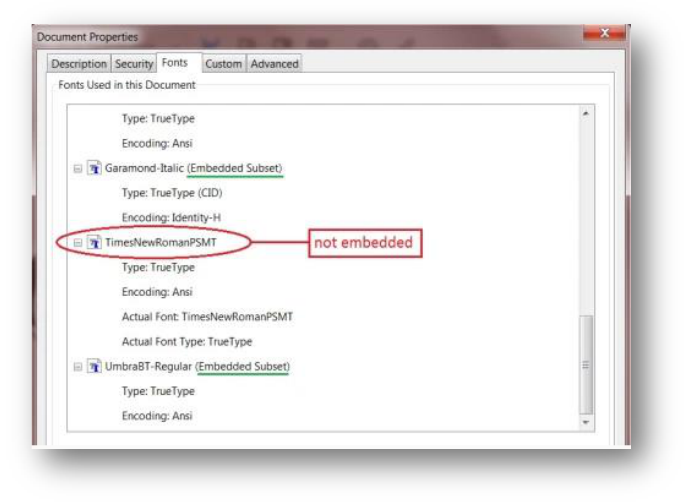
PDF FAQs Page 5 of 15
On the Font tab you will find a list of all the fonts used in your document. Next to each one you should see
‘(Embedded Subset)”. It is underlined in green on the above screen shot. If you see a font name without
“Embedded Subset” next to it (circled in red above), that means the font is loose and may be replaced with
some other font when the reader opens the document (or tries to read or print your document).
To make sure that all of your font subsets are embedded in your Word document you can start by using
one of the 14 fonts that do not have to be included or embedded in the PDF as they are expected to be
present on all computers. These 14 fonts are:
Time New Roman
Times New Roman Bold
Times New Roman Italic
Times New Roman BoldItalic
Helvetica
Helvetica Bold
Helvetica Oblique
Helvetica BoldOblique
Courier
Courier Bold
Courier Oblique
Courier BoldOblique
Symbol
ZapfDingbats
To make sure that all font subsets of your Word document embed in your PDF, follow the steps below.
1. With your Word document open, click the File tab
2. From the file navigation pane, select “Options”

PDF FAQs Page 6 of 15
3. The Word Options dialog box opens up. This controls all of your document settings. Click Save on the
navigation pane as shown circled in red.
4. This will open up the Save options, one of which includes the option to “Embed fonts in the file” (also
circled in red).

PDF FAQs Page 7 of 15
5. Click Embed fonts in the file. Then uncheck both “Embed only the characters used in the document”
and “Do not embed common system fonts”. TimewNewRomanPSMT is one of those ‘common system
fonts’ which Word saves documents in without the author’s knowledge. “Times New Roman” changing to
“TimesNewRomanPSMT” when a document is saved as PDF from Word seems to be a known issue. See
https://answers.microsoft.com/en-us/msoffice/forum/msoffice_word-mso_win10/font-changes-from-times-
new-roman-to-times-new/5040d093-8cd9-46ab-819b-ebfeb238f72e?page=1
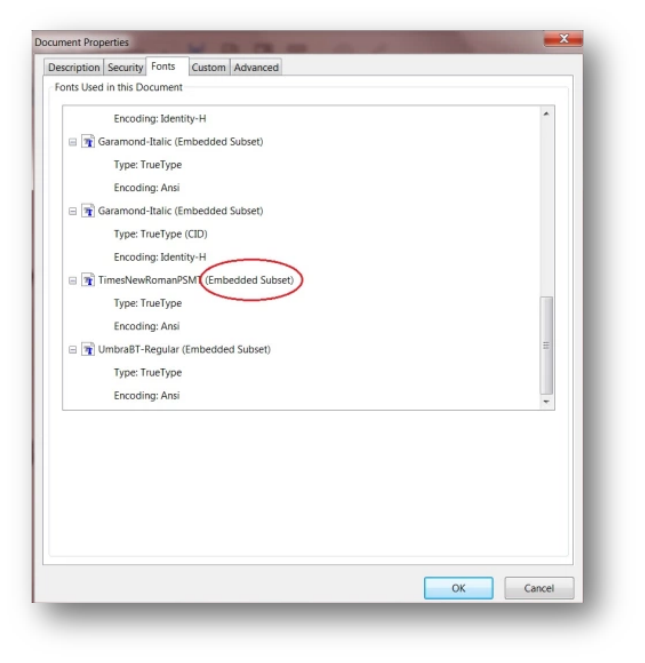
PDF FAQs Page 8 of 15
6. Finally, click OK to save your Word file and then convert it to a PDF file. This time when you open the
new PDF with Adobe Reader and check its properties, you should see that all font subsets are embedded,
or something like this:

PDF FAQs Page 9 of 15
Creating PDF from Word 2016
1. Open Word document
2. Select File from the menu bar
3. Click on Save As
4. In the Save as type drop down select PDF
5. Select the Options box
6. From the Options window make sure to deselect under PDF Options ISO 9005-1 compliant (PDF/A)
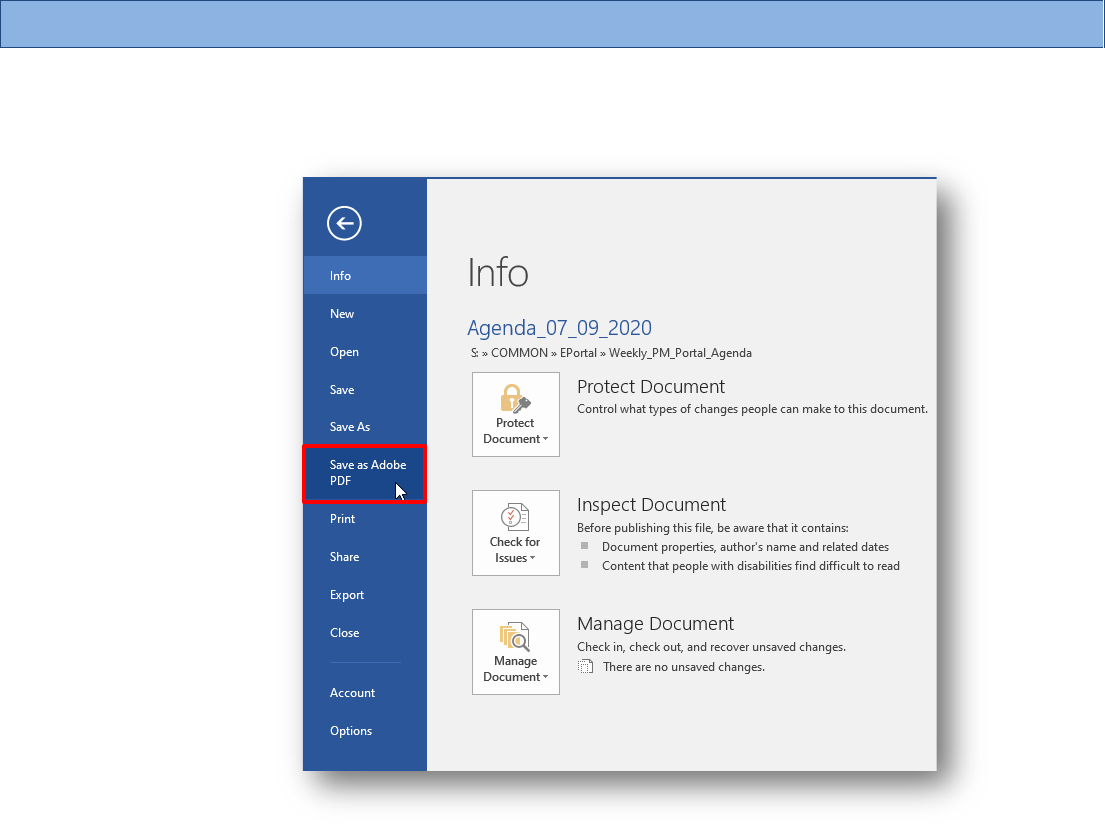
PDF FAQs Page 10 of 15
In Word 2016 if you try to create a PDF/A, the words get jumbled. It would be better to submit the Word
document or create a PDF and submit to the Portal so that the Portal can then create a compliant
PDF/A document until you upgrade to the latest version of Word.
Save your Word 365 document as a PDF/A with Adobe Acrobat
1. Open your document in Word (for Windows)
2. Click File > Save As and choose Save As Adobe PDF (*.pdf) from the side bar
3. From the Save Adobe PDF File As, select Options
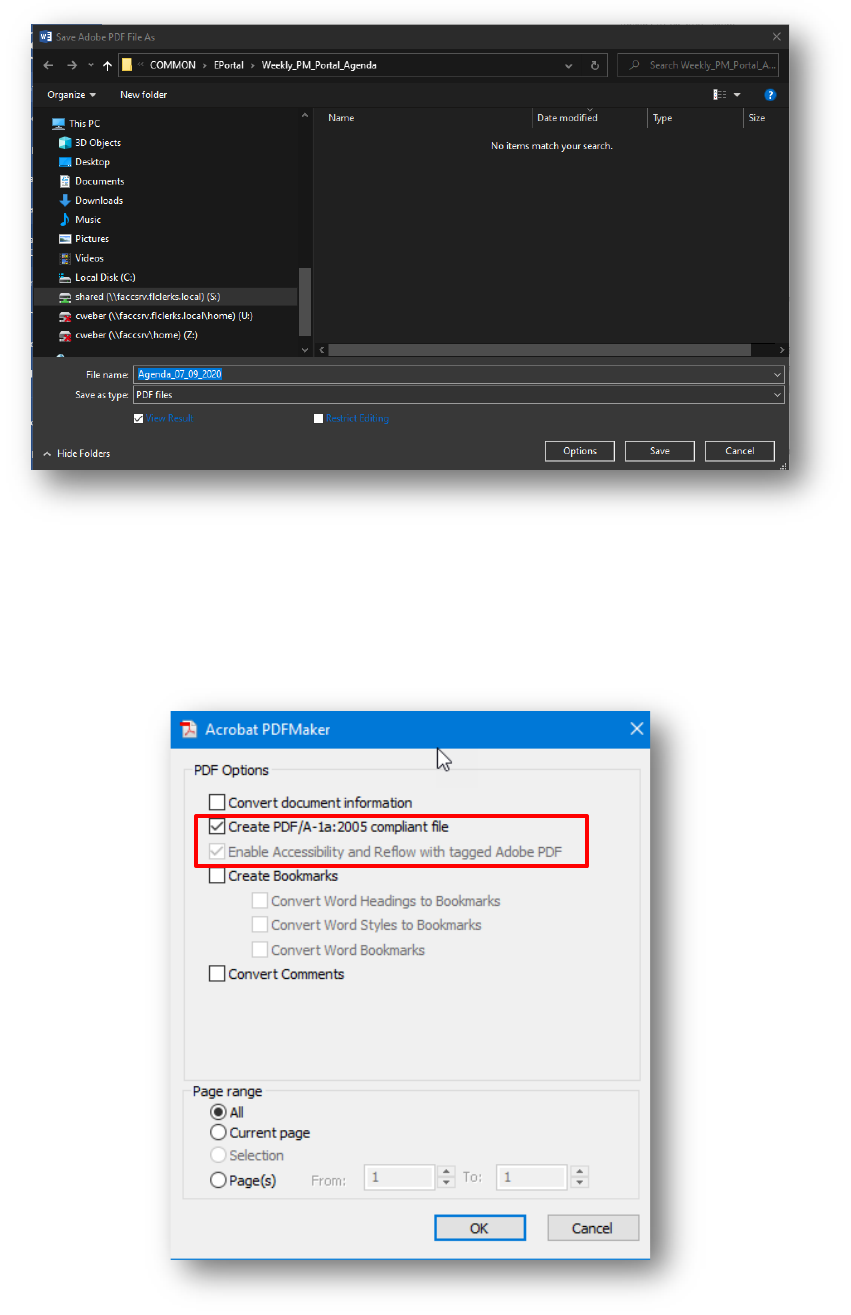
PDF FAQs Page 11 of 15
By default the File name is the same as that of the original Word document, but with the .pdf
extension. You may enter a different file name if you wish.
4. Click the Options... button and from PDF Options select:
5. Click OK on the Options dialog; then click Save to create the PDF/A-compliant file.
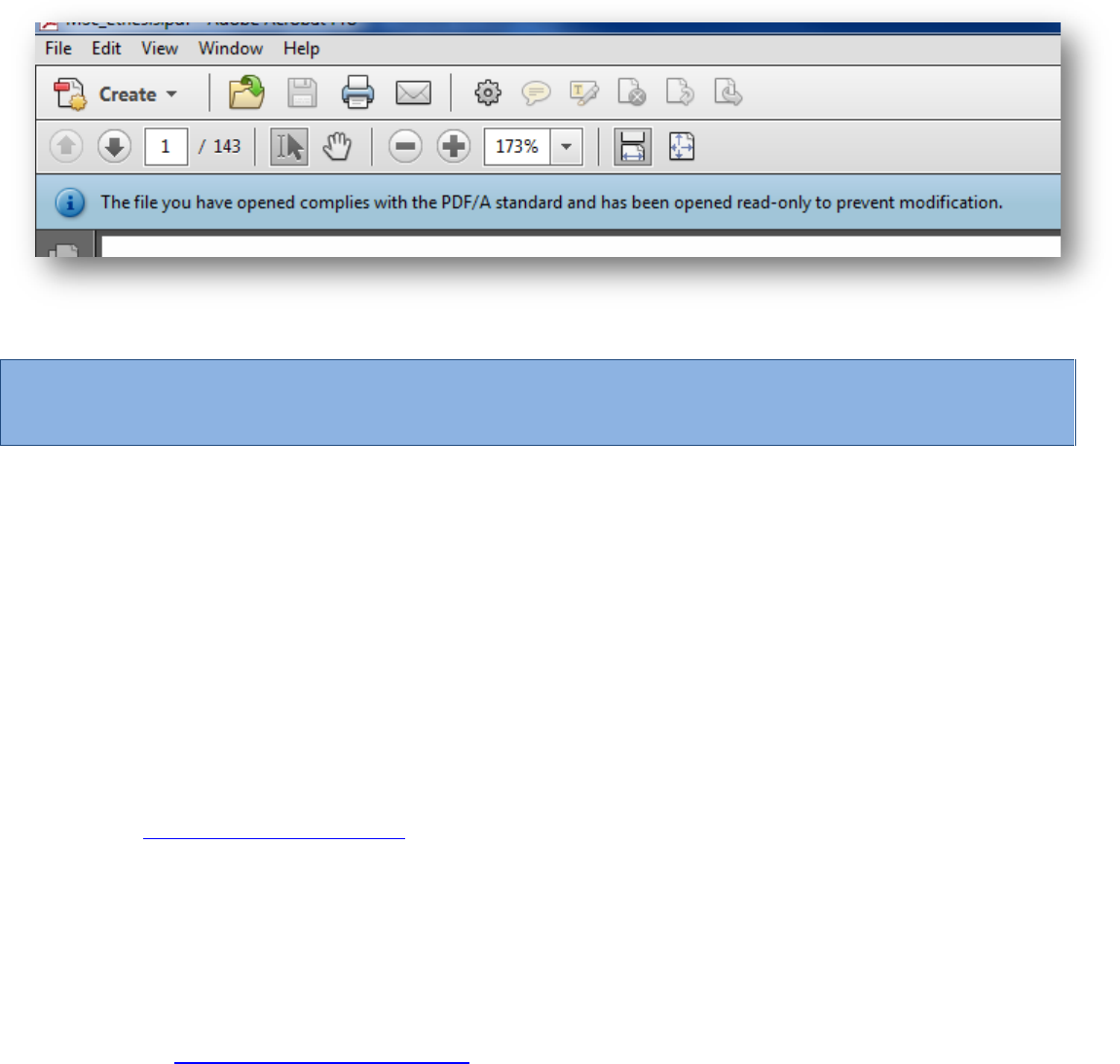
PDF FAQs Page 12 of 15
If you open the newly created .PDF file in Adobe Acrobat or the free Adobe Reader you should see a message
signifying that the file complies with the PDF/A standard. When this document is viewed in Portal Review, the
same message indicating that the file complies with the PDF/A standard will be visible.
Converting a file to PDF/A-1a compliant or Font-embedded
versions.
PDF/A is an archival format of PDF that embeds all fonts used in the document within the PDF file, meaning
that a user of you file will not have to have the same fonts that you used to create the file installed on their
computer in order to read it. Some of the solutions provided below will ensure that all fonts (including common
system fonts) are embedded, but do not provide full compliance with PDF/A standards.
If you have Microsoft Word 2008 on a Mac
1. Choose File > Save As
2. Change the File Type to PDF
3. Save. Fonts are automatically embedded in Word 2008. (Note: This version is not fully PDF/A
compliant. Also, previous versions of Microsoft Word do not automatically embed fonts).
Online Converters:
Pros: System independent... use is the same if you have a PC or a Mac
Cons: Some have file size limits that won't allow them to convert large files.
CometDocs - http://www.cometdocs.com/
Not true PDF/A conversion, but it will embed all fonts used in your document.
1. Click 'Browse' and choose your file (will accept Microsoft Word .doc and .docx files, among others.)
2. Choose PDF Create
3. Enter your e-mail address
4. Click Send
5. In a few minutes, you'll receive an e-mail with a link to go to the site and download your file. It will say:
"Here is your file converted by CometDocs:"
PDF Converter - http://www.freepdfconvert.com/
Not true PDF/A conversion, but it will embed all fonts used in your document.
1. Click 'Browse' and choose your file (will accept Microsoft Word .doc and docx files, among others.)
2. Enter your e-mail address
3. Click Convert Your File
4. In a few minutes, you'll see 'Job Done'. Click on 'Download your file' to open your file. (It will be in a
Zipped folder).

PDF FAQs Page 13 of 15
Be cautious using free online open source PDF applications and be sure that you check the Document
Properties to make certain all guidelines have been applied.
PDF/A –How to Make Them; How to Verify Them
Creating the PDF/A Document
If Word is your document processor, you may want to set your preferences in Acrobat to always save your
PDF as a PDF/A1-a format. To set your Preferences follow the steps below in #1.
1. If you have your document open in MS Word: Preferences already set
a. Save your document in MS Word (don’t close) and then go to the Acrobat ribbon in Word
b. Click on ‘Preferences’
c. Click on the Conversion Settings drop down in the PDFMaker Settings box
d. Select PDF/A-1b (2005) RGS
e. Click on OK at the bottom of the Preferences box
You have now set your preferences to always save your documents to a PDF/A1-b default and will no
longer have to specify what type of PDF/A you are creating. To change this format to a later version,
follow the steps above and select the PDF/A version you are updating to.
2. If you have your document open in MS Word: Preferences not set in Acrobat
a. Save your document in MS Word (don’t close) and then go to the Acrobat ribbon
b. Click ‘create pdf’
c. Name the file and select a location to save
d. Click ‘options’
e. Check the box labeled ‘Create PDF/a-1b:2005 compliant file’
f. Click ‘OK’
g. Click ‘Save’
3. If you are in Acrobat, and your Word document is saved locally:
a. In the upper left hand corner, click ‘create’
b. In the drop down menu, select ‘PDF from File . . .’N
c. Navigate to the file you want to convert to PDF/A
d. Select the file and click ‘open’
e. Go to the file menu, choose ‘save as other’ and then select ‘Archivable PDF (PDF/A)’
f. Name the file, and select a destination folder
g. Click ‘Save’
4. If you are in Acrobat, and you already have your document saved locally in PDF format:
a. If your document is not open, go to <File> and select <Open>
b. Navigate to your PDF document, and click <Open>
c. Click on <File> and select <Save As Other . . . > then select from the submenu, <Archivable PDF (PDF/a)
d. Name the file, and select a destination folder
e. Click ‘Save’
How to check your work –Verifying PDF/A Compliance

PDF FAQs Page 14 of 15
If the Navigation Pane is open, you will see a gray strip down the left hand side of the screen. If not, go
to<view><show/hide><Navigation Panes><show navigation pane>. NOTE: Do not click on <view><page navigation>.
Right click in the empty gray strip on the right and select <standards>
Click on the link labeled ‘Verify Conformance’
Check the ‘Status’ indicator just above the ‘Verify Conformance’ link. It should now read ‘verification succeeded’.
PDF/A Conformity
Getting a file to clear the true CONFORMITY is not easy. You basically cannot scrub any metadata for it to
pass. For example: if you take a file that has had its metadata scrubbed and run it through the, “VERIFY
CONFORMITY” it will fail. The reason it will “fail” is because when you scrub metadata part of that is the
metadata, “pdfcreator” which can be scrubbed. The “pdfcreator” tag, apparently is required to pass the
CONFORMITY test.
Metadata Scrub
To be a true PDF/A, we may need to modify the metadata rules a bit. As the rules read right now, they require
ALL metadata to be scrubbed to be truly compliant with the Portal. Perhaps a slight modification to “any
metadata that is not required for compliance standards shall be removed from submission”. That way, we can
leave the metadata that is required of a PDF/A to VERIFY CONFORMITY and still be able to comply with all of
the Portal rules and standards.
PDF/A and ADA Compliance
Steps to make your document both PDF/A and ADA compliant:
1. With document created within Word:
a. First make sure the Info is complete; i.e., click File, click Info (if not automatically there). On the
right of the screen, fill in the Title, Tags, Comments, Status, Categories, Subject with necessary
information as appropriate. (At least fill in Title, Tags)
b. Save document; go back to document screen
2. In the upper menu bar, click ACROBAT
a. Click the second from the left option: Preferences
b. Under “Convert Document Information”, you will see: “PDF/A Compliance”. Open those options
and choose necessary option: I chose PDF/A-2a
c. Make sure you have other choices chosen, i.e., Create Bookmarks, Add Links
d. Click OK
3. Choose most left option: Create PDF (may need to save it again prior to conversion)
a. Click Tools (on top right of screen)
b. Once open, choose Accessibility
c. Once open, choose Full Check
4. Document will be reviewed for ADA compliance. On the left will be the list of compliance fields. Under
Documents, there will probably be three issues indicated. Open that list.
a. Three items should not have check marks: Logical Reading Order, Title, and Color contrast
b. Right click on Logical Reading Order; choose Pass
c. Right click on Title; choose Fix

PDF FAQs Page 15 of 15
d. Right click on Color contract; choose Pass
Scanned Documents
Scanned files are a disaster from the beginning. A scanned PDF is a snap shot of the document and can
never be made a PDF/A. If it is made a PDF/A so you can get the banner, it will rarely pass the conformity
test. The very nature of a PDF/A is that it is a totally self-contained file. If the original PDF does not have all
the data, there is no way the PDF/A can have the data.
